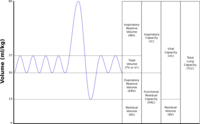
Photo from wikipedia
Background and Aims: PEEP is commonly used to improve postoperative respiratory outcomes in surgical and ICU patients. It is thought to increase ICP by impending CSF outflow and cerebral venous… Click to show full abstract
Background and Aims: PEEP is commonly used to improve postoperative respiratory outcomes in surgical and ICU patients. It is thought to increase ICP by impending CSF outflow and cerebral venous drainage. Hyperventilation is used to decrease ICP in patients having intracranial hypertension. We investigated the effect of various levels of PEEP and EtCO2 on ONSD as an indirect predictor of ICP in patients undergoing surgery under GA. Methods: After induction, different levels of PEEP and EtCO2 were applied to 50 patients. Sonographic ONSD was measured 5 minutes after stabilization of each new setting. Haemodynamic parameters like pulse, SpO2, BP were also recorded. Quantitative variables were expressed as Mean ± SD and compared across between follow-ups using paired t-test. Qualitative variables were expressed in number and percentage. Results: Baseline ONSD was 0.44 ± 0.06 cm. It increased significantly to 0.45 ± 0.07 cm, 0.47 ± 0.07 cm and 0.49 ± 0.07 cm after applying PEEP of 8, 12 and 15 cm H2O PEEP, respectively. It significantly decreased to 0.42 ± 0.06 cm, 0.41 ± 0.06 cm and 0.40 ± 0.06 cm after hyperventilation, EtCO2 range 35–37, 32–34 and 29–31 mm Hg. Results were statistically significant but clinically not significant. Conclusion: We conclude that there are acute and dynamic alterations in ONSD in response to hyperventilation and presence of PEEP in anaesthetised patients. Ocular sonography may be used as a reliable indicator of acute variations in ICP.
Journal Title: Indian Journal of Anaesthesia
Year Published: 2019
Link to full text (if available)
Share on Social Media: Sign Up to like & get
recommendations!